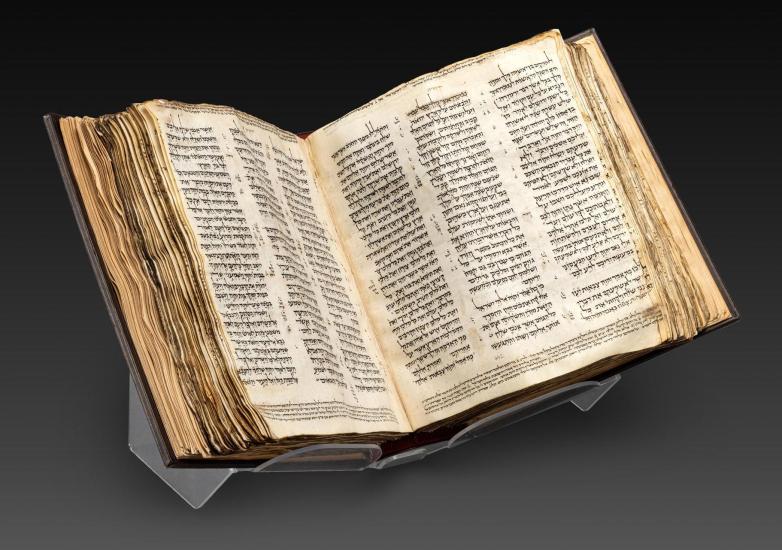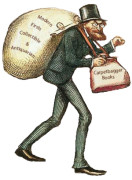Oldest Near-Complete Hebrew Bible Set to Fetch $50 Million at Auction

The Codex Sassoon
Sotheby's will bring the Codex Sassoon - the earliest, most complete Hebrew Bible extant, dating to the late ninth century - to auction in May.
Composed of 24 books divided into three parts—the Pentateuch, the Prophets, and the Writings—the Hebrew Bible makes up the foundation for Judaism as well as the other Abrahamic faiths: Christianity (in which these texts are referred to as the Old Testament, and are incorporated into the biblical canon by the Catholic, Orthodox, and Protestant sects, among others); as well as Islam, which also holds the stories of the Hebrew Bible in special regard, with many of them included in the Qur’an and other significant works of Islamic literature.
In the centuries prior to the very first codices, or manuscript in book form, of the Hebrew Bible, of which Codex Sassoon is the earliest most complete copy extant, there existed only portions or sections of biblical texts in scroll form. These manuscripts, known as the Dead Sea Scrolls, date as far back as the third century B.C.E. and were produced through the first century C.E.
However, these early biblical texts were copied in scroll format without punctuation or vocalization and contained no verses or chapters. The correct reading and comprehension of the biblical text found in the corpus of the Dead Sea Scrolls was not easily apparent. Instead, Jews in antiquity relied on inherited oral traditions, passed down from one generation to the next, to understand, preserve, and the transmit the sacred words of the Hebrew Bible.
The codex is named for its prominent modern owner, David Solomon Sassoon (1880-1942), who assembled the most significant private collection of Judaica and Hebraica manuscripts in the world. Sassoon had a special affinity for Bibles in particular, and some of the most valuable and important items in his library belonged to this genre of Hebrew literature. His collection catalogue, Ohel Dawid, begins and ends with biblical material, and Sassoon 1053 is its very last entry, giving pride of place to this monument of medieval Jewish civilization.
The Codex now comes to auction from the renowned collector Jacqui Safra, whose decades-long stewardship of the text produced the definitive scientific evidence, through authoritative carbon dating, confirming scholars' earlier research and making it of similar age to the Aleppo Codex, though the Codex Sassoon is significantly more complete.
Coming to auction for the first time in more than 30 years with an estimate of $30/50 million, Codex Sassoon will be the most valuable printed manuscript or historical document by estimate ever offered at auction. The auction will take place in New York this May, alongside Sotheby’s marquee sales of Contemporary and Modern Art, one of the most high-profile and anticipated moments of the annual auction calendar. Sotheby’s recently established a new benchmark for historical text and manuscripts at auction with the sale of a first printing of the U.S. Constitution in November 2021 for $43 million, a record price.
While Codex Sassoon has been recognized for its importance by scholars for generations, it has remained virtually out of public view for centuries and will be exhibited for the first time in 40 years at Sotheby’s London (February 22 - 28), before moving on to Tel Aviv (week of March 20), Dallas (week of April 17), Los Angeles (week of April 30), and finally New York in early May.
“Codex Sassoon marks a critical turning point in how we perceive the history of the Divine word across thousands of years, and is a transformative witness to how the Hebrew Bible has influenced civilization for centuries,” said Sharon Mintz, Sotheby’s Senior Judaica Specialist, Books & Manuscripts.
History
Several owners’ notes found on the pages of this manuscript attest to the travels of the Codex. An entry dating to the early eleventh century references a sale by Khalaf ben Abraham, perhaps a Near Eastern businessman active in the Land of Israel and Syria, to Isaac ben Ezekiel al-Attar, who later transferred ownership to his two sons, Ezekiel and Maimon.
In the thirteenth century or later, the Codex was dedicated to the synagogue of Makisin (present-day Markada in northeastern Syria). It was probably rebound at this stage, and an anonymous hand added a dedicatory inscription to its pages: “Consecrated to the Lord God of Israel to the synagogue of Makisin.” Surprisingly little is known about the Jewish history of Makisin except that the famed early twelfth century Norman convert to Judaism Obadiah ha-Ger passed through the town on his way from Aleppo to Baghdad. The local Jewish community must have been a prominent one to have held such a prized manuscript as Codex Sassoon, much as the communities of Aleppo and Damascus came into possession of several important Hebrew Bibles, most famously the aforementioned Aleppo Codex.
The book’s last premodern inscription tells a fascinating story: the town of Makisin was destroyed—perhaps by the Mongols in the 13th century or by Tamerlane’s troops in 1400—and the codex had to be removed from the synagogue. It was entrusted to the care of a community member, Salama bin Abi al-Fakhr, who was required to return it if the synagogue of Makisin were to be rebuilt. The handwriting of this inscription suggests the end of the fourteenth century or later. It is possible that the book itself suffered damage during the destruction of the town. If so, its survival adds yet another layer of mystery and wonder to this rare Hebrew Bible.
However, as Makisin was destroyed, the synagogue was never rebuilt, and the odyssey of the Codex continued for centuries until it was ultimately acquired in 1929 by David Solomon Sassoon. Sassoon, one of the most celebrated and renowned collectors of Jewish texts, affixed his bookplate to the inside cover of the binding, where is remains today, adding to the book’s storied lineage.
The Text
The existence of the Codex puts to end the great “silent period” in which virtually no Hebrew literature survives from the last of the Dead Sea Scrolls in the second century until the ninth century. In the ninth century, however, the production of Hebrew books suddenly and dramatically blossomed, and the extraordinary and thrilling emergence of monumental and sophisticated Hebrew biblical codices after seven centuries of a total void of Hebrew books cannot be overstated. The emergence of Codex Sassoon at this time plays a crucial role in understanding how the Hebrew Bible evolved from antiquity to the modern age.
The first examples of Biblical texts are found among the ancient scrolls discovered in the Judean hills near the Dead Sea. Known as the Dead Sea Scrolls, these manuscripts date as far back as the third century B.C.E. through the first century C.E., during the period when the Second Temple still stood in Jerusalem. Among this corpus are about 230 fragments containing parts of all the books of the Hebrew Bible except the book of Esther. Although the text preserved in these scrolls bears a strong resemblance to that known today, there are also differences that demonstrate that the Hebrew Bible remained in flux in antiquity.
However, the Dead Sea Scrolls, like Torah scrolls, were written without punctuation, vocalization, or accentuation. Words are separated by spaces, paragraph divisions break up the flow of the text, and four letters (alef, he, vav, and yod) are frequently used to mark certain vowels, but even with these devices, the correct pronunciation and parsing of the biblical text into intelligible units is not readily apparent from its appearance in a scroll. Instead, Jews in antiquity relied on inherited reading traditions, passed down orally from one generation to the next, to understand the Bible.
In the early Middle Ages, not before the sixth century but also not later than the seventh, Jewish Bible scholars known as Masoretes (from the Hebrew word masorah meaning tradition) commenced a project that would stabilize the biblical text and develop systems of committing its reading traditions to writing. The most of important of these systems—named “Tiberian” for the city of Tiberias on the Sea of Galilee where the leading school of Masoretes worked —would, with time, become the standard one used throughout the Jewish world to record the vowels and accents of the Hebrew Bible and create the definitive text of the Hebrew Bible.
In addition, to ensure that scribes would copy the Biblical text correctly, The Masoretes drew up extensive lists containing the how often words appear in the Bible, the details of the correct spelling as well as its proper vocalization and accentuation of the texts. These notes, collectively known as the Masorah (lit., Tradition) were written in the top and bottom margins of the Bible as well as between the columns of text . The tradition of Aaron Ben Asher (first half of the tenth century), scion of a famous family of Tiberian Masorah scholars, was considered particularly authoritative. Manuscripts that feature the biblical text together with the notes of the Masorah are known as Masoretic Bibles, and those that closely follow Ben Asher’s tradition, as Codex Sassoon does, are prized above all others.
The Hebrew Bible is a large work composed of twenty-four separate books, and copying its text, vowel points, and accent marks, together with the Masorah, onto large pieces of parchment was an expensive proposition that only wealthy patrons could afford to sponsor.
Only two codices comprising almost the entire Hebrew Bible and dating to the tenth century have survived into the modern era: the present Codex Sassoon and the Aleppo Codex. The latter was created in Tiberias circa 930 and has long been recognized as preserving an exceptionally accurate version of the biblical text. Unfortunately, almost two-fifths of the Aleppo Codex, including the vast majority of the Pentateuch and parts of the Writings, were lost under mysterious circumstances sometime in the 1940s or 1950s. By contrast, Codex Sassoon, which has been dated to the late ninth/early tenth century on both scientific and paleographic grounds, contains almost the entirety of the Bible and lacks only twelve full leaves. It is thus the earliest, most complete copy of the Hebrew Bible extant. The earliest complete Hebrew Bible, known as the Leningrad Codex, is dated 1008 almost a full century later.
















